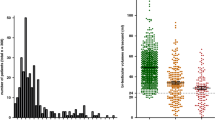Abstract
Testicular testosterone (T) production was examined in thirty boys with undescended testes (UT) following the administration of 4500 U gonadotropic hormone. Twenty boys had bilateral UT and ten had UT plus hypospadias. As for possible causes of reduced Leydig cell activity it was investigated whether the testis was (1) hypoplastic; (2) abnormally fused with the epididymis; (3) located in the abdomen; (4) or UT was associated with hypospadias. Average T values were significantly lower when the testicle was hypoplastic or its fusion with the epididymis was imperfect; but remained largely undiminished when the testicle was located in the abdomen or when UT was combined with hypospadias. The occurrence of both pathologic and physiologic T reactions in each of the four groups suggests that the population of UT children is heterogeneous, probably due to differences in aetiology and in intrauterine hormonal processes. In the case of UT and hypoplasia the time and method of operation (orchidopexy) must be selected with utmost care, bearing in mind that an originally small testicle with impaired T secretion may become physiologic by the time of puberty.
Similar content being viewed by others
References
Albescu, I. Z., Bergada, C., Cullen, M.: Male fertility in patients treated for cryptorchidism before puberty.Fertil. Steril., 22, 829 (1971).
Baker, B. A., Morley, R., Lucas, A.: Plasma testosterone in preterm infants with cryptorchidism.Arch. Dis. Child., 63, 1198 (1988).
Bellinger, M. F.: Embryology of the male external genitalia.Urol. Clin. North. Am., 8, 375 (1981).
Bidlingmaier, F., Dörr, H. G., Eisenmenger, W., Kuhle, U., Knorr, D.: Testosterone and androstendione concentrations in human testis and epididymis during the first two years of life.J. Clin. Endocrinol. Metab., 57, 311 (1983).
Bramble, F. J., Houghton, A. L., Eccles, S., Jacobs, H. S.: Reproductive and endocrine function after surgical treatment of bilateral cryptorchidism.Lancet, 311 (1974).
Gendrel, D., Roger, M., Job, J. C.: Plasma gonadotropin and testosterone values in infants with cryptorchidism.J. Pediatr., 97, 217 (1980).
Grant, D. B., Laurence, B. M., Atherden, S. M., Ryness, J.: HCG stimulation test in children with abnormal sexual development.Arch. Dis. Child., 51, 596 (1976).
Imperato-McGinley, J., Guerrero, L., Gautier, T., Peterson, R. E.: Steroid 5-alfa reductase deficiency in man: An inherited form of male pseudohermaphroditism.Science, 186, 1213 (1974).
Jirasek, J. E.: Development of the Genital System and Male Pseudohermaphroditism. Johns Hopkins Press, Baltimore 1971).
Johansen, T. E. B.: Anatomy of the testis and epididymis in cryptorchidism.Andrologia, 19, 565 (1987).
Madersbacher, H., Kövesdi, S., Frick, J.: Zur Fertilität beim einseitigen Kryptorchismus.Urologe [A],11, 210 (1972).
Merksz, M., Tóth, J.: Testicular-epidydimal fusion abnormality in undescended testis.Int. Urol. Nephrol., 19, 179 (1987).
Rivarola, M. A., Bergada, C., Cullen, M.: HCG stimulation test in prepubertal boys with cryptorchidism, in bilateral anorchia and in male pseudohermaphroditism.J. Clin. Endocrinol. Metab., 31, 526 (1970).
Sulcova, J., Jirasek, J. E., Straka, L.: Transformation of testosterone to dihydrotestosterone by the primordia of human genitalia and by the fetal suprascapular skin.Steroids Lipids Res., 4, 129 (1973).
Tóth, J.: Paediatric Urology in General Medicare (in Hung.). Medicina, Budapest 1986.
Tóth, J., Merksz, M., Szőnyi, P.: States causing infertility in adulthood in children with undescended testis.Acta Chirurgica Hungarica, 28, 243 (1987).
Waaler, P. E.: Endocrinological studies in undescended testis.Acta Paediatr. Scand., 65, 559 (1976).
Walsh, P. C., Curry, N., Mills, R. C., Siiteri, P. K.: Plasma androgen response to HCG stimulation in prepubertal boys with hypospadias and cryptorchidism.J. Clin. Endocrinol. Metab., 42, 52 (1976).
Author information
Authors and Affiliations
Rights and permissions
About this article
Cite this article
Merksz, M., Tóth, J. & Pirót, L. Testosterone secretion in children with undescended testis. International Urology and Nephrology 24, 429–437 (1992). https://doi.org/10.1007/BF02550638
Accepted:
Issue Date:
DOI: https://doi.org/10.1007/BF02550638




